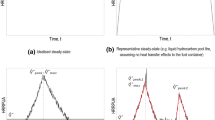Abstract
The objective of the present study is to evaluate the elevated fires using the metrics of smoke distribution and changes in fire signals at the early stage, which affect activation of fire detectors. Most previous works on elevated fires in compartments are mainly concerned with physical phenomena of fully-developed fires. However, fire signals at initial 60 s are key parameters for aircraft cargo fire detection. A series of elevated fires were conducted in a simulated Boeing 737–700 forward cargo compartment. The fuel mass loss rate, the vertical and ceiling temperature, gas concentrations and relative humidity (RH) were measured. Results show that the smoke layer interface remains constant for various fuel pan elevation heights and no clear smoke stratification phenomenon is observed during the early stage, nevertheless, the first indication of smoke has been raised. The ceiling temperature rise is attenuated at different rates for various elevations with an exponential model proposed in ceiling temperature distributions for early stage fires. 60 s after ignition of the elevated fires, compared to non-elevated fires, CO/CO2 concentrations increase by at least 3.73/1.49 times and O2 concentration decreases by 2.5 times. The RH increases at the early stage. These experimental results can be used to inform the selection of optimum sensors, to develop appropriate detection algorithms and to optimize the number and location of fire detectors.















Similar content being viewed by others
References
Federal Aviation Administration (2014) Airworthiness standards: transport category airplanes part 25.858. GPO’s Federal Digital System. http://www.ecfr.gov/cgi-bin/text-idx?rgn=div5;node=14%3A1.0.1.3.11#14:1.0.1.3.11.4.181.79
Blake D (2000) Aircraft cargo compartment smoke detector alarm incidents on us-registered aircraft, 1974–1999. Federal Aviation Administration. http://www.fire.tc.faa.gov/pdf/tn00-29.pdf
Bell K (2011) Cargo compartment smoke detector AS8036 standard revision, Society of Automotive Engineers International. http://www.fire.tc.faa.gov/pdf/systems/Nov11Meeting/Bell-1111-AS8036.pdf
Chen SJ, Hovdeb DC, Petersona KA, Marshall AW (2007) Fire detection using smoke and gas sensors. Fire Saf J 42(8):507–515. doi: 10.1016/j.firesaf.2007.01.006
Girdhari A (2008) Aircraft cargo compartment multisensor smoke detection algorithm development. Federal Aviation Administration. http://www.tc.faa.gov/its/worldpac/techrpt/ar0758.pdf
Beyler CL (1984) Ignition and burning of a layer of incomplete combustion products. Combust Sci Technol 39(1–6):287–303. doi: 10.1080/00102208408923793
Beyler CL (1986) Major species production by diffusion flames in a 2-layer compartment fire environment. Fire Saf J 10(1):47–56. doi:10.1016/0379-7112(86)90031-7
Poulsen A, Jomaas G (2012) Experimental study on the burning behavior of pool fires in rooms with different wall linings. Fire Technol 48(2):419–439. doi:10.1007/s10694-011-0230-0
Yuan M et al. (2012) A simplified mathematical model for predicting the vertical temperature profiles in enclosure fires without vertical opening. Fire Technol 50(4):929–943. doi:10.1007/s10694-012-0315-4
Zukoski E (1978) Development of a stratified ceiling layer in the early stages of a closed room fire. Fire Mater 2:54–62
Cetegen BM (1982) Entrainment and flame geometry of fire plumes. Ph.D Thesis, California Institute of Technology, Pasadena, USA
Sugawa O, Kawagoe K, Oka Y, Ogahara I (1989) Burning behavior in a poorly-ventilated compartment fire-ghosting fire. Fire Sci Technol 9:5–14
Li C, Lu S, Yuan M, Zhou Y (2010) Studies on ghosting fire from pool fire in closed compartments. J Univ Sci Technol China 40:751–756 (in Chinese)
Mounaud L (2004) A parametric study of the effect of fire source elevation in a compartment. Master Thesis, Virginia Polytechnic Institute and State University, Virginia, USA
Zhang JQ, Lu SX et al (2012) Smoke filling in closed compartments with elevated fire sources. Fire Saf J 54:14–23. doi:10.1016/j.firesaf.2012.08.003
Zhang JQ, Lu SX et al. (2013) Experimental study on elevated fires in a ceiling vented compartment. J Therm Sci 22(4):377–382. doi:10.1007/s11630-013-0639-5
Zhang JQ, Lu SX et al (2013) Impacts of elevation on pool fire behavior in a closed compartment: a study based upon a distinct stratification phenomenon. J Fire Sci 31(2):178–193. doi:10.1177/0734904112460203
Oztekin ES (2014) Heat and mass transfer due to a small-fire in an aircraft cargo compartment. International Int J Heat Mass Transf 73:562–573. doi:10.1016/j.ijheatmasstransfer.2014.02.019
Blake D, Suo-Anttila J (2008) Aircraft cargo compartment fire detection and smoke transport modeling. Fire Saf J 43(8):576–582. doi:10.1016/j.firesaf.2008.01.003
EN-54 (1984) Part 9, Fire sensitivity tests. BSI Standards
Society of Automotive Engineers International (2013) AS8036 Cargo compartment fire detection instruments. Aerospace Standard
Krull W et al (2006) Design and test methods for a video-based cargo fire verification system for commercial aircraft. Fire Saf J 41(4):290–300. doi:10.1016/j.firesaf.2005.07.009
Rangwala AS (2002) Mathematical modeling of low ventilation compartment fires, Master Thesis, University of Maryland, USA
Utiskul Y, Quintiere JG, Rangwala AS, Ringwelski BA, Wakatsuki K, Naruse T (2005) Compartment fire phenomena under limited ventilation. Fire Saf J 40:367–390. doi:10.1016/j.firesaf.2005.02.002
Karlsson B, Quintiere JG (2002) Enclosure fire dynamics. CRC Press, New York
Quintiere JG (2002) Fire behavior in building compartments. Proc Combust Institute 29(1):181–193. doi:10.1016/S1540-7489(02)80027-X
Cooper LY, Harkleroad M, Quintiere J, Rinkinen W (1982) An experimental study of upper hot layer stratification in full-scale multi room fire scenarios. J Heat Transfer 104:741–749
NFPA 92B Guide for smoke management systems in malls, atria, and large areas. National Fire Protection Association. 2000
McCaffrey B (1995) Flame height SFPE handbook of fire protection engineering, 2nd edn. National Fire Protection Association, Quincy
Ji J, Fan CG, Zhong W, Shen XS (2012) Experimental investigation on influence of different transverse fire locations on maximum smoke temperature under the tunnel ceiling. Int J Heat Mass Transf 55(17–18):4817–4826. doi:10.1016/j.ijheatmasstransfer.2012.04.052
Acknowledgments
This study was supported by Institute of Advanced Technology, University of Science and Technology of China under the Technology Innovation Project (Advanced Aircraft Cargo Compartment Fire Detection Technology).
Author information
Authors and Affiliations
Corresponding authors
Rights and permissions
About this article
Cite this article
Wang, J., Lu, S., Hu, Y. et al. Early Stage of Elevated Fires in an Aircraft Cargo Compartment: A Full Scale Experimental Investigation. Fire Technol 51, 1129–1147 (2015). https://doi.org/10.1007/s10694-015-0475-0
Received:
Accepted:
Published:
Issue Date:
DOI: https://doi.org/10.1007/s10694-015-0475-0




